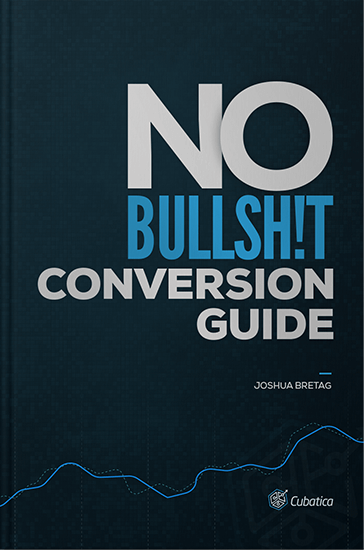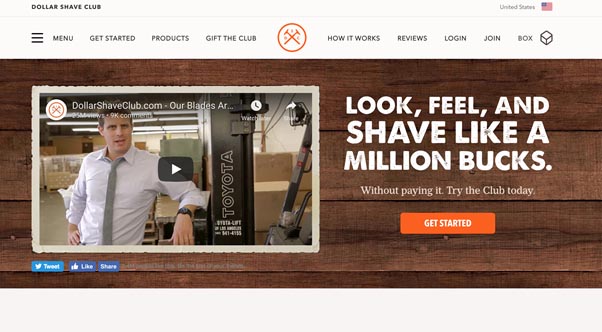
Target audience: CMO’s/marketing managers/VP’s, business owners who are looking to improve their sales, lead generation and growth.
Purpose of piece: to analyze and deconstruct Dollar Shave Club’s digital marketing and growth strategy, providing advanced, in-depth actionable tips for audience based on what DSC is and isn’t doing well. To tell an interesting story about Dollar Shave Club and how they grew their
Introduction
The most successful marketing campaigns don’t just tip toe into the marketplace. They’re built to shake industries up, to grab eyeballs, and roar their message across platforms.
Dollar Shave Club has become legend in marketing and startup history for doing just that with their innovative approach to growth marketing.
They startled a skeptical business world by disrupting the men’s grooming industry. Now, many other startups turn to Dollar Shave Club for entrepreneurial inspiration. DSC shows other startups how to compete with the big boys – and win.
Wrestling market share away from an industry giant like Gillette is no mean feat, and they’ve blasted a new path for ecommerce with the subscription model. The current global shaver market is worth $15 billion in size and 75% had been cornered by Gillette – until now.
In this epic case study, we’re going to take apart Dollar Shave Club’s digital marketing and growth strategy piece by piece so you can learn from it. We’ll also give you mind-blowing, in-depth, actionable tips to take back to your own marketing teams.
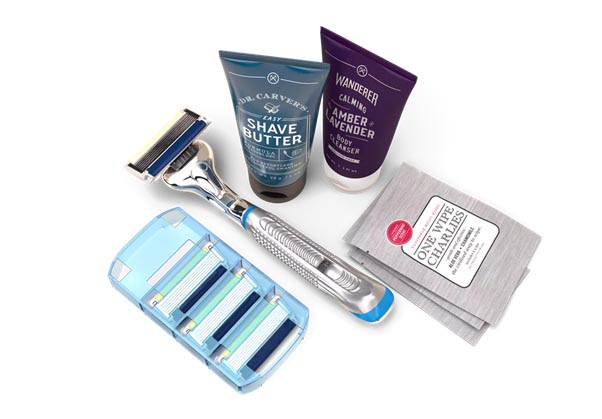
DSC’s meteoric rise to fame started with the all-important comedic viral video, but where did they go from there? Building a brand doesn’t just begin and end with one insanely popular ad. What have they been doing, and what can they do now, to make sure they keep getting more sales?
We’ll show you right now.
The Dollar Shave Club story
The Dollar Shave Club (also known as DSC) is a company that started out as a monthly subscription service for razor blades. It was a fairly simple concept.
You pay anywhere from $3-$9 USD per month, and they send you razors in the mail, so you never run out. Convenience aside, it was a heck of a lot cheaper than the going rate for a single pack of razors from the “razor fortress” at the drugstore.
Co-founder Michael Dubin was a long-time serial entrepreneur, but prior to DSC his other ideas hadn’t come to much. He knew that subscription razor blades were the million dollar idea, which struck him like lightening at a holiday party. Mark Levine, another party-goer and friend’s father, agreed.
They became business partners and started raising funding. In the end, it was a mixture of their own personal savings and venture capital that got Dollar Shave Club off the ground. It was lucky that Dubin’s magnetic personality and serious shop talk could convince skeptical VCs to open their wallets.
Dollar Shave Club went into business in January 2011. The following April, their website was live. They just needed a genius marketing campaign with enough firepower to get their business off the ground.
Cue… that video. You know, the one with the CEO (Dubin), the tennis racket, forklift, man in a bear costume, employee Pedro, and the raining dollar bills. All executed with perfect comedic timing.
The video was made possible by Dubin’s training in comedy improvisation which he learned at night classes, and which certainly set it leagues apart from your average marketing fare. Dubin took a risk.
And it worked like a charm.
Now, what they’re REALLY well-known for is gaining 12,000 new subscribers in the first 48 hours of releasing the video, and going on to corner 15% of their market share in four years.
In 2016, DSC were so hot they were acquired by Unilever for a cool $1 billion. Being backed by such a large corporate would give Dubin the freedom to pursue the company’s vision.
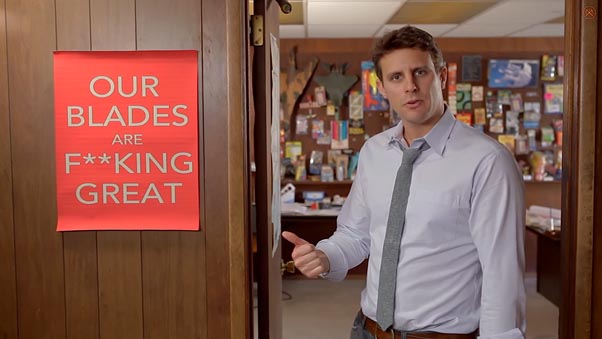
So that’s how they got started. Let’s dive right in and look at the elements that made Dollar Shave Club’s first campaign such a roaring success, plus the mechanics of their ongoing strategy. As a bonus, we’ll also explore areas they can tweak in their marketing right now to achieve even bigger growth in 2018.
A sneak peek into Dollar Shave Club’s viral marketing
Typical men’s grooming ads normally promise to turn you into a chiseled male model if you buy their product. Instead, DSC connects directly with its audience’s funny bone through offbeat humor and irreverent approach to marketing its product.
One of Dollar Shave Club’s superpowers is just how they approach their marketing. Through deliberate brand positioning, DSC has reached the point where their customers don’t really see their promotional materials as ‘marketing’. And that’s the dream.
Most of the time, their market sees DSC’s social interactions as a form of entertainment, something to make them laugh… As we know, masking marketing as entertainment is one of the ways to fast track yourself into your customer’s hearts… and wallets.
It screams creativity and significantly contributes to the strength of their branding and positioning:
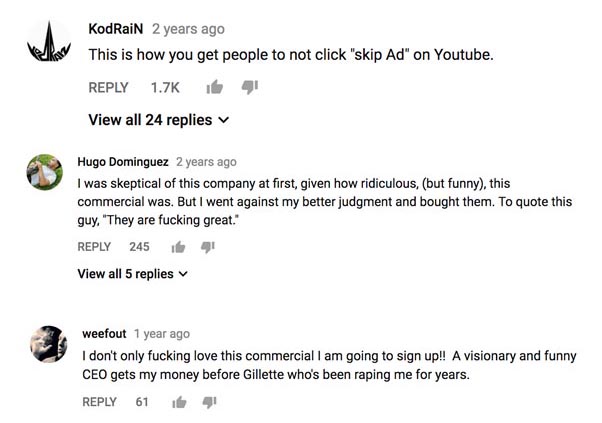
People genuinely appreciate being so entertained. By making such a bold attempt at humor, DSC are making themselves vulnerable and risking a potentially negative reaction – or worse, crickets.
It’s a form of satirical marketing where they brand themselves as bucking the marketing trend for grooming products. That’s cliched, hyperbolic, hyper-masculine adverts that promise a complete personality overhaul through the simple act of shaving or washing.
By calling their video ‘Our Blades are F***ing Great’, this plays on the lazy technique of men’s grooming products of not-so-subtle overselling. It humorously makes their message explicit, and their audience loved it.
A viral video is one thing, but it would be nothing without a website that’s wired to convert. It may not be the most exciting marketing channel you can think of, but it should be your number one investment when it comes to digital marketing.
Website UX
So they’ve managed to attract attention with a brilliant marketing video, but what do they offer once customers flock to their website?
A heck of a lot, it turns out. As an ecommerce subscription company, they know that their brand is their website. They’ve put in as much love and care as you would with a bricks-and-mortar store.

Perhaps after viewing the video or being referred by a friend, you hit their homepage. Immediately you sense that their site is a well-oiled machine. We know that DSC were split-testing different versions of their site at the time, which is an effective way of finding out which design has the highest conversion rate.
DSC’s style is in the details. Using the wood-texture background pattern gives the impression of a vintage barber shop. This is continued subtly throughout the site.
Now, we’ll take a quick look at a predictive heatmap of their homepage.
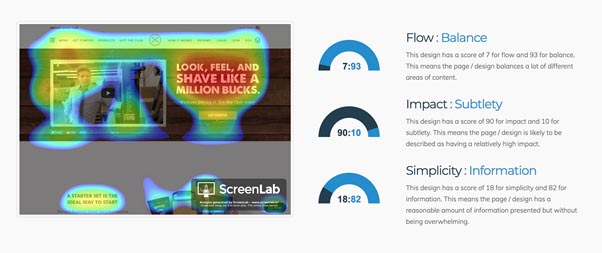
Online users will spend roughly 80% of their time looking at information they see above the page fold (Nielsen Norman). It’s hard to sustain their attention even when they do scroll downwards.
DSC’s copy is very carefully chosen. They market themselves as a ‘men’s grooming club’, with ‘members’ rather than customers. As soon as you hit the homepage, you know you’re onto something special.
DSC anticipates their users’ needs by getting to the point, and quickly. The user knows that DSC wants them to hit the orange button, and they are not distracted with competing calls-to-action.
Product pages
You click the button and land on their exquisite product pages.
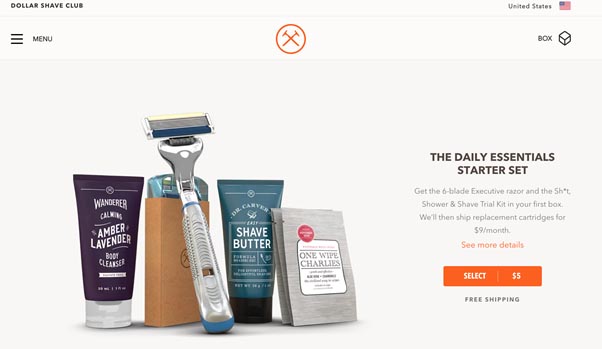
Dollar Shave Club smashes it with their product imagery, which is all-important for an ecommerce brand.
We’d say their new design is way superior to their old one. In their ‘blades’ section of the product pages, they’ve gone from a crowded, slightly old-fashioned looking page to a new streamlined version that works much better.
Before:
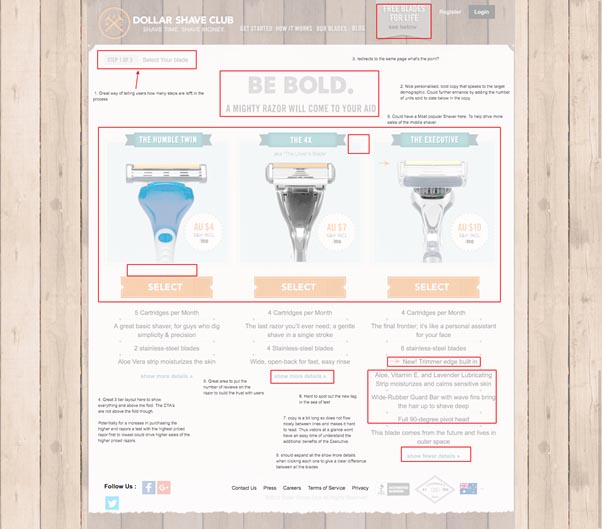
After:
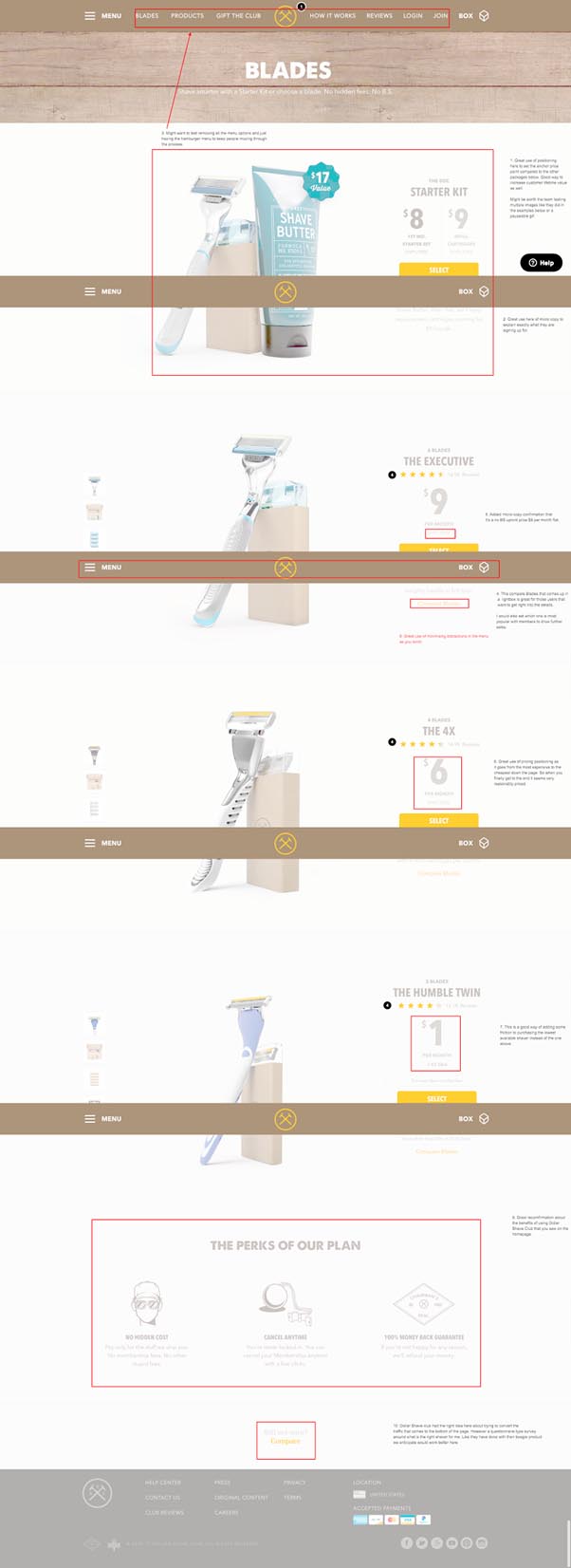
It’s sleek. It’s stylish. It looks more like a traditional print magazine advert than an ecommerce product page.
They also make fantastic use of product reviews to add social proof. This helps convert more browsers into customers, since people are more likely to buy a product after reading favorable (genuine) peer reviews.
By calling their customers ‘members’, DSC emphasizes that reviewers are part of their exclusive club and therefore more trustworthy.
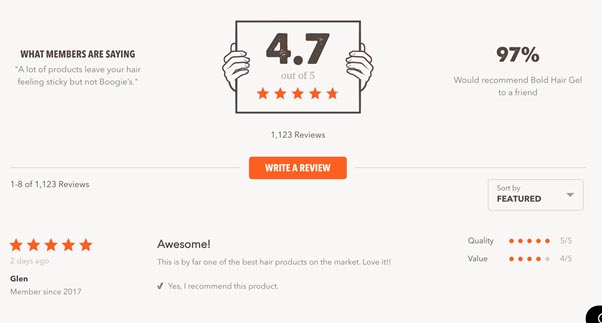
The checkout process
So customers are hooked and they can’t wait to part with their credit card details. But DSC isn’t done with them yet.
They strike while the iron is hot and take advantage of the opportunity to upsell to their customers while they are just hitting the check out. Customers may not have even thought about buying related products, and DSC are doing them a favor by putting this opportunity in front of them.
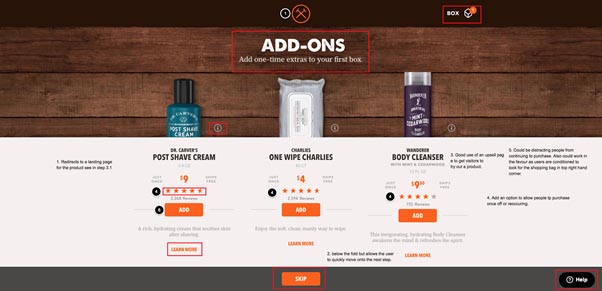
At the checkout, they ask you to join their club. This makes the business relationship more of a two-way street than the user just becoming another one of their many customers.
It also has the positive effect of making the normally boring process of ‘creating an account’ more fun, and adds to the DSC customer experience. In the spirit of UX, they’ve made the account form very simple – but they could have included some small additions that would encourage the customer to make their first purchase.
For example, they could have included another testimonial on this otherwise plain page, and spiced up the micro copy to make it more on brand. At the moment, it’s a little bland.
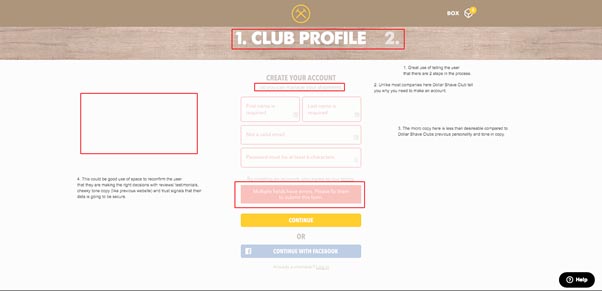
By enabling Facebook authentication, they smooth the account creation and remove one of the most common barriers to conversion (filling in details).
Granted, some customers won’t feel comfortable using social media logins, but at least they can choose between social login and filling in their details (while other companies sometimes make social login mandatory). Some people prefer a little more privacy.
The billing page
The billing page is the holy grail of the conversion process. Once your customers have submitted their payment details, you’ve hit your goal.
That’s why it’s funny that many companies drop the ball when it comes to the billing page, even after spending lots of money designing slick product pages. This kind of behavior sends a message to your customers that says “We’ve got your money, so now we don’t care” – but this wouldn’t be DSC’s style.
Instead, DSC continues their upmarket aesthetic with a sleekly designed billing form. It avoids awkward dropdown menus, many mandatory fields and confusing language (several common traits of billing forms), and instead is a delight of User Experience.
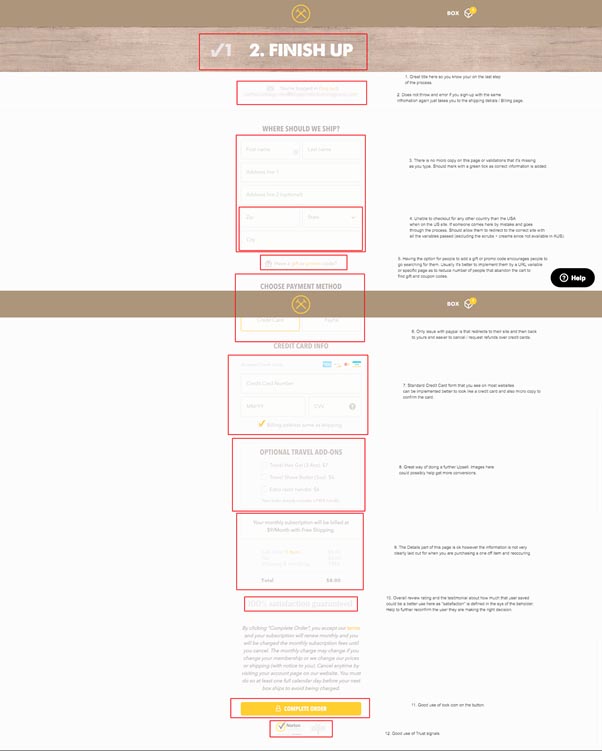
Their billing page is a continuation of their overall customer experience, with simple language and direct communication.
There are some problems with it, though. There is no micro copy to prompt people when they don’t fill out forms correctly, since the pre-filled copy disappears once a user starts typing. Users are easily distracted, and in this case they have no way of rediscovering the purpose of a field once they’ve forgotten. This encourages customers to leak out of the conversion funnel and should be fixed immediately.
DSC have also missed an opportunity to include testimonials or other trust factors at this crucial stage of the funnel. Including trust factors reminds customers they are making the right decision with this purchase.
The older version of their billing page had quite a few problems, which they’ve luckily managed to fix. For one, they didn’t tell customers what credit cards they accept or if the payment platform is secure.
Some of the fields such as the shipping address were a bit confusing, and they’d missed an opportunity to autofill the state/province information. Terms & Conditions were absent, which, in Australia’s case, is breaking the law.
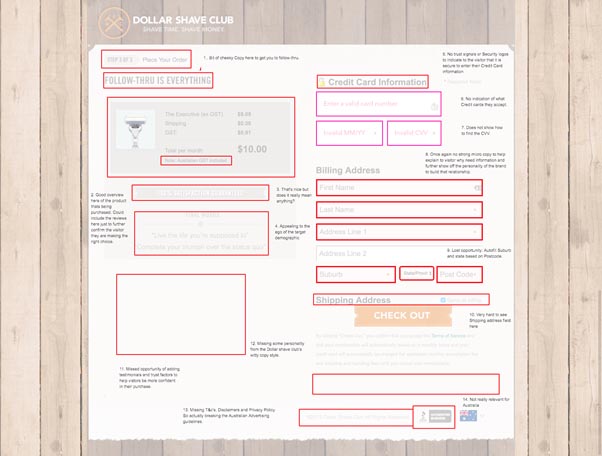
DSC have fixed most of these issues now and their new form is a lot more sleek.
Once you’ve purchased your razor subscription, DSC also follow up with emails direct to your inbox. These give the customer yet another opportunity to add more products before their order ships. This is another great example of upselling and maximizing the value of each order.
Recommendation: Brand-building pays off in the long-term because it means you can have the confidence to deliver exactly one call-to-action above the fold on the homepage of your website. Concentrate all your energies into moving all your site visitors down the conversion funnel towards the sale. Avoid distracting them with unnecessary demands on their attention.
The cancellation process
DSC’s cancellation process is also praiseworthy because they give customers the option to change their plan, by adjusting their delivery to every two months rather than one.
By including this added flexibility, they’ve increased the chance they can maintain a long-term relationship with every customer (the ultimately goal of the subscription model). They can then upsell to them again later down the line.
They also use whimsical copy to disguise this sneaky tactic of persuading the customer to keep their subscription. They’ve also obscured the cancellation button by labelling it as ‘Other Options’, and in fact it’s not even a button.
This is risky in case it upsets customers who find it too difficult too cancel. We’d be interested to know how this tactic worked out for them.
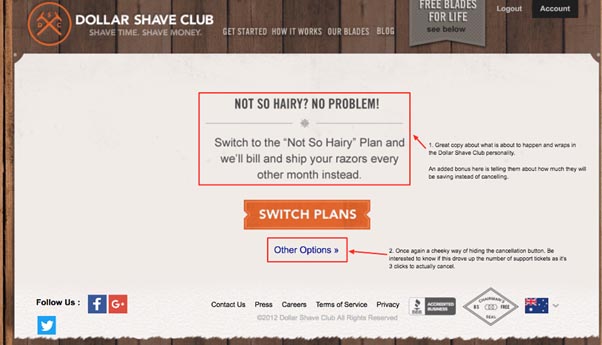
Their copy presents the cancellation process like a break up, which hopefully should make their customers laugh. We’d be interested to know how many it has persuaded to keep their subscription.
Account pages
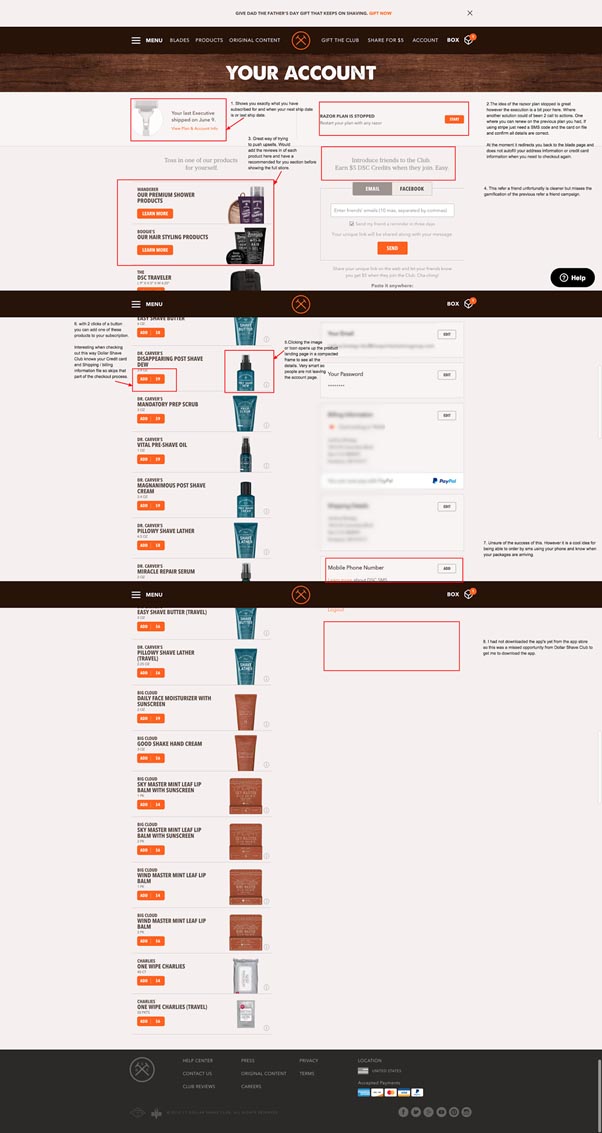
They’ve heavily invested in the design of their account pages as well which is unusual. Businesses tend to allocate most of their sales budget to acquiring new customers but DSC put just as much effort into upselling to existing ones. This is the right way to execute the subscription model.
They also upsell to their customers after they’ve ordered by enabling them to add more products before their order ships (increasing lifetime valueLife Time Value, and far cheaper than acquiring a NEW customer). It’s not only a fantastic way to increase the value of an existing order, but also ensures customers don’t miss out.
UX Summary
DSC knows their target audience – men who shave – incredibly well. This is reflected in their brand’s tone. DSC clearly funnels a huge amount of resources and budget into their website and have optimized it for conversions by emphasizing one call-to-action. A customer can’t help but convert.
There were some small changes they could have made to smooth the conversion funnel even more but overall this is a well-optimized site, as proven by their ongoing success.
One feature that really stands out is how much they value their subscription customers, who get just as much attention as potential new customers. This is exactly how it should be in any business but especially ones operating on the subscription model.
Landing pages
When you create any landing page for your campaigns, it must have these six qualities:
- Identity
- Credibility
- Relevance
- Social Proof
- Urgency
- Usability
We’ll take a look at DSC’s landing pages with these qualities in mind.
Their most popular landing page receives almost 80% of their paid traffic is a version of their homepage. It contains their introductory offer of a $1 dollar razor for new customers and the famous viral video starring Dollar Shave Club’s founder. They’ve been running it on Taboola on and off since July 2017.
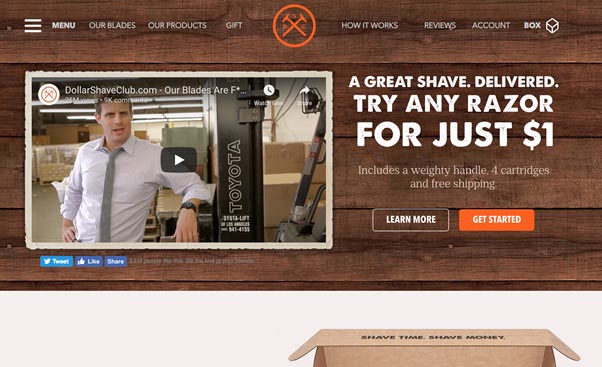
Let’s take a quick look at the design of their landing page. They’ve got a clear call-to-action and an appealing offer for their potential customers on a page that’s easy to use. It’s limited by a narrow focus above the fold and has a catchy headline to tell customers why they need this deal. By including their well-known video, they’re adding to their credibility.
As you scroll down, DSC includes a lot of information about their services. To improve conversions, they should ditch all of this extra stuff and just focus on getting customers to take the $1 deal. Also, they haven’t included any social proof, so there are no customer reviews telling future customers why this is an absolutely unmissable deal.
This is something they have tested extensively in the past so we’d be interested to know how the conversion rates compare between this landing page and others.
One of their landing pages that did really well was their ‘Meet the man who is disrupting a $13 billion industry’.
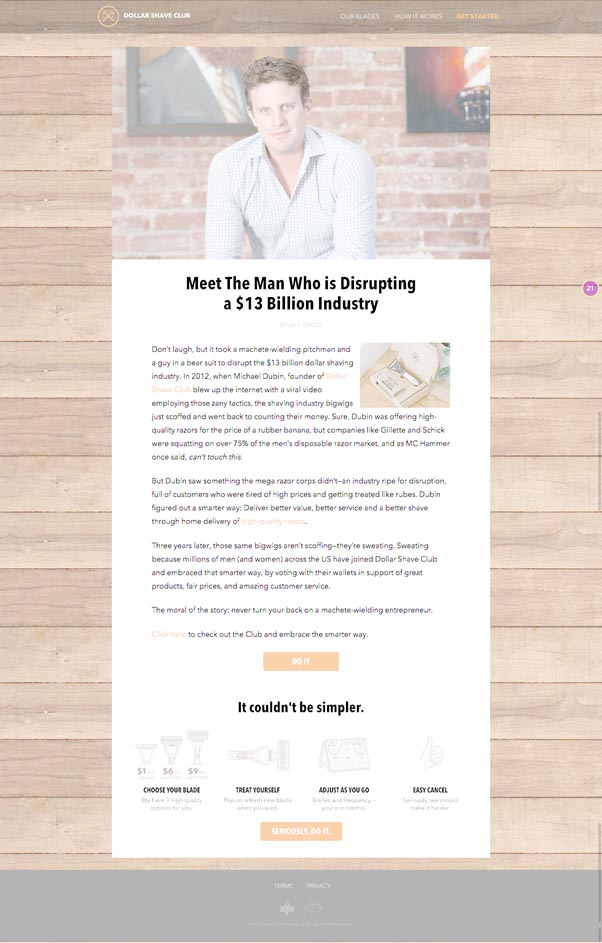
It works because it is written like a third party editorial that extols the virtues of Dollar Shave Club. It’s highlighting the clever innovation behind their subscription model and their surprise success against Gillette. It suggests that, by becoming one of DSC’s ‘members’, you will also be joining this exclusive club of loveable rogues.
It’s also really simple and uses one of the most powerful copy call-to-actions of all time: “do it”.
Recommendation: When running paid campaigns it’s fundamentally important to use custom landing pages, since these have a higher rate of conversion. Split test a few versions of your landing page to see which performs better. Use visual cues to draw the user’s eye towards the primary CTA button, such as arrows, or an image of a person looking towards it.
Since the traffic to these landing pages are from very generic sites like weather.com, DSC needs to be sure they’ve used a very clickable headline to attract more attention from users.
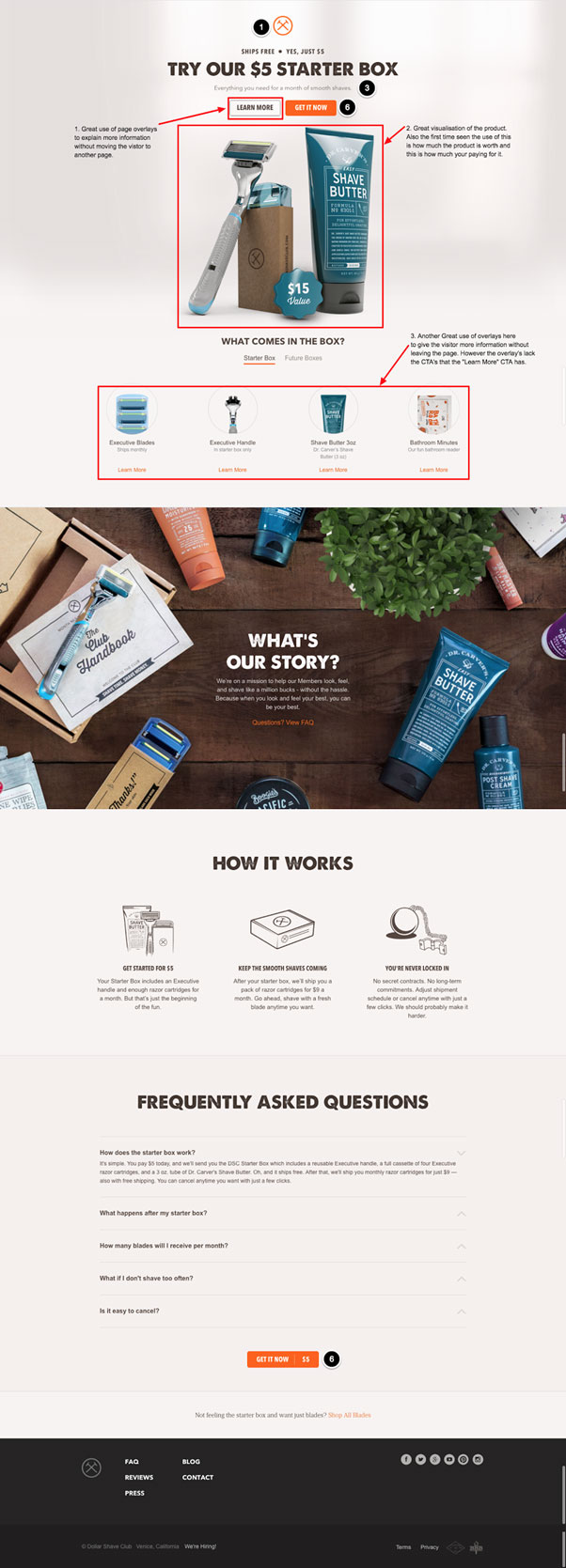
This is another landing page for their $5 starter set which has a similar layout but is missing their signature video. This makes the landing page a lot cleaner and less distracting because you’re focusing on getting customers to sign up to buy your product.
Cleverly, DSC dynamically populates some of their landing pages using URL parameters. It saves a lot of effort in the long run as you only have to build one page with multiple elements, instead of building 500+ pages. The URL of the landing page specifies what content displays to the user.
Landing pages are an integral part of your advertising campaigns, but it’s important to invest enough effort into your SEO strategy. We’ll go into DSC’s SEO strategy next.
Search Engine Optimization for Dollar Shave Club
Optimizing for search engines should be relatively easy for such a well-known brand. They’re already getting substantial traffic after their video and they market really well, so the bulk of the hard work is already done.
DSC need to make sure they regularly tend to the less glitzy but nonetheless important elements of SEO like targeting high-traffic keywords, building a link profile and ensuring their site is fast at loading, among other things.
Domain authority
You’d think that a site with such a popular video to its name would have it easy when it comes to domain authority, but that’s not quite true.
The highest domain authority a site can get is 100 (with a lowest score of 0) and Dollarshaveclub.com has a domain authority of 71. This is pretty good but definitely is an area they could improve on.
A higher domain authority makes it more likely a site will rank for targeted keywords and show up first in the search results. This increases traffic, backlinks, and results in a virtuous circle.
At the moment, a lot of popular marketing sites (like Adweek.com) regularly link to DSC’s website, which works in their favor. They get links from some other high authority domains like Lifehacker, Weebly, Mashable, Techcrunch and moz.
Their top referrers are deals sites like Swagbucks and Mypoints. The users of these types of sites can’t resist a good subscription deal, which explains their popularity. DSC market themselves based on their value compared to other better-known brands.
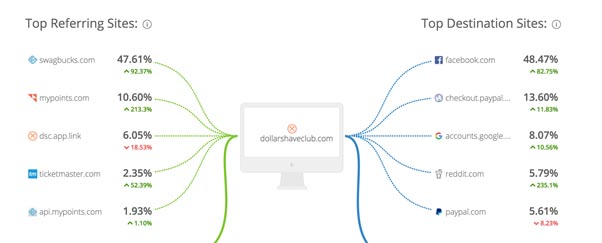
They could improve their domain authority by cultivating more high authority links from a variety of relevant sites. They could execute a good guest posting strategy that includes partnerships with complementary, non-competitive brands like HelloFresh or Everlane.
Keyword targeting
Keyword targeting is an integral part of any SEO campaign, and yet many businesses are under-utilising this important area.
In fact, most brands are not taking advantage of all the industry keywords and phrases that could lead to an increase in conversions for their site. This is a shame because organic search has a 14.6% close rate, compared to 1.7% for outbound marketing (Source).
So far, DSC has not invested much effort in organic keyword targeting. They mainly rank for their brand name and the industry keywords they do rank number one for are not driving much traffic. They are getting a lot of traffic from keywords that aren’t particularly relevant to their brand. For example, 1.5 million hits for the word ‘match’.
DSC clearly focus most of their efforts on email marketing and referral marketing, but there is a lot of potential for growth in their SEO strategy.
DSC could target more popular industry keywords such as ‘razor’, ‘shaving foam’, ‘clippers’ and even ‘toothbrush’ to get more of a footprint in the SERPs.
If they work on their positioning for the word ‘razor’, for which they currently rank 8th but gets them a whopping 90,000 hits a month, they could see a massive increase traffic. For example, they could build backlinks to their blades page (currently ranking for this term), which would improve page authority.
Recommendation: Even if you are implementing an SEO strategy, there may be crucial on-page factors that are messing up your results. Address these as quick wins and improve your on-page SEO.
For example, make sure you only have ONE h1 tag per page (Dollar Shave Club has several on their homepage). Ensure your h1 tag (your title) contains your SEO keyword for your page, and also fill in the alt text of your images for extra search visibility (DSC has not used alt text).
Make sure you use the other h tags in the proper hierarchy to organize your content for search engines.
Site speed
Another on-page SEO factor is site speed. DSC need to make sure those beautiful razors are loading quickly!
It’s important that DSC optimizes their site speed for faster page loading times, as this is an important ranking signal. If users landing on a site are kept waiting, they’re much more likely to click away prematurely (bounce), so Google penalizes this.
According to Google’s Site Speed analysis tool, Dollarshaveclub.com’s page speed on desktop needs work, while their mobile rating is considered poor.
To make the desktop and mobile sites load faster:
- Allow browser caching so the site can load from the local disk rather than over the network
- Eliminate render-blocking JavaScript and CSS to allow above-the-fold content to load first
- Enable compression of some resources so file sizes are smaller
- Minify JavaScript to reduce its size and speed up load times
Perhaps they’re more focused on conversions through their mobile app, and that’s why they haven’t devoted much time to improving their mobile site speed.
Title tags and meta descriptions
The search terms ‘Dollar Shave Club’ bring up great results. Their title tag is relevant and snappy, while their meta description is straight to the point, guiding the user towards a purchase.
DSC is taking up lots of real estate in the SERPs so that anyone searching for their company is extremely likely to click on one of their links.
Their result contains deeper site links so users can click through to more relevant pages if they want to. It’s showing the navigational structure of the site which users can use to decide if the result is relevant for them (answer: hopefully, yes).
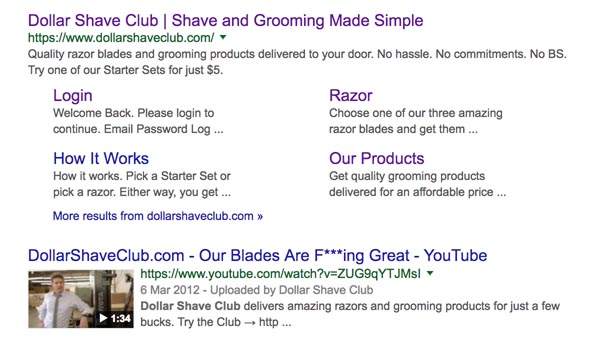
Their YouTube video is the second result which adds to their branding and recognition. It’s another fantastic link for users to click on that takes them down the conversion funnel.
So at the moment DSC are doing pretty well with their metadata, but there are some points they can improve on such as their h tags.
Backlink analysis
Gaining quality backlinks is another very important way that your company will improve its ranking in the SERPs. Your backlinks are an indication of your site’s authority and quality.
In general, you should try to outrank your competitors with a diverse set of high authority backlinks, and avoid spammy backlinks.
DSC gained 100,130 new backlinks in the last 90 days.

The majority of these backlinks are through text. They come from a variety of different websites including other ecommerce brands, shopping coupon websites and news or marketing sites. This reflects the fact Dollar Shave Club has a broad appeal with several different target markets, prompting many different sites to link to it.
If we take a quick look at one of their main competitors, Harry’s (another subscription razor service), we can see that their main backlinks are recently coming from media sites.
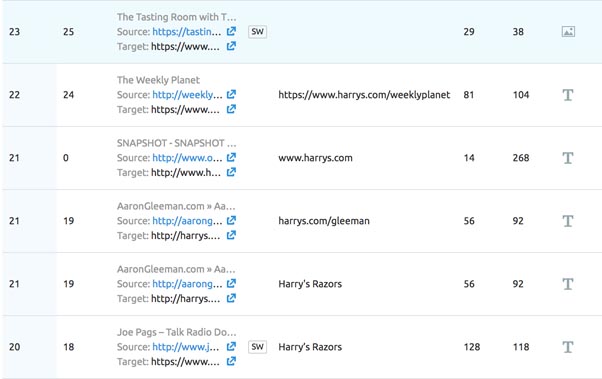
As part of their link-building strategy, DSC can target some of these sites, since their history with Harry’s means they may be likely to give them a backlink as well. On the other hand, if these are official partners, DSC will do better to target other similar brands.
Dollar Shave Club’s social media presence
Social media is where DSC clearly spends much of their marketing budget, but sometimes their results on social can be mixed. While they get a fair bit of engagement on some of their Facebook posts, frequently their tweets leave a little to be desired.
12% of of DSC’s overall organic traffic is from social media, the majority from Youtube and the rest from Facebook. This is in keeping with their viral video, which will go on to send a lot of traffic to their site from YouTube (and Facebook, where DSC also host their video).
Their traffic from Pinterest, Twitter and Reddit is minimal. Overall their social media presence is strong, but it could use some work.
DSC runs two twitter accounts, one solely devoted to customer care and the other as their brand account. They put a lot of effort into sharing custom graphics for their followers’ amusement.
They’re going for a men’s lifestyle vibe, which is reflective of their overall content marketing strategy. They touch on some risky topics like butt shaving (or manscaping) in their posts, which are just on this side of being Safe For Work.
Avoid looking like a freshly plucked turkey with these tips from a pro manscaper. 1/6 pic.twitter.com/vVmcg343Rp
— Dollar Shave Club (@DollarShaveClub) November 22, 2017
For such a large brand with a following close to 100,000, they don’t get much engagement with most of their tweets. Many companies struggle to get customers to convert on Twitter but there are some things DSC could do.
They could use social listening tools to actively approach potential customers who are asking about the type of products they sell. For example, they could jump in on this conversation about a subscription razor service with an offer for their product:
I like the idea of a subscription razor service, it would mean that I wouldn’t need to sign for a small loan for a pack of Gillette blades
— Chris Jones (@ChrisJ_94) September 27, 2017
US fast food chain Wendy’s is a prime example of how to do Twitter really well as a brand. They are a humorous account that really knows its target audience and gets away with being a little bit edgy. They’re even sassy towards competing brands like McDonalds, and their fans love it! DSC could learn from Wendy’s.
Some customers have also taken to Twitter to complain about the amount of online advertising they have seen from DSC, which they consider borders on spam.
They’ve also complained in large numbers about the company apparently being ‘pro Sean Hannity’ through their sponsorship of the Fox News presenter’s talk show. Hannity had seemed to defend Republican Senate nominee Roy Moore who was accused of underage sex.
Political dissent is an unavoidable component of Twitter, but DSC responded by pulling their sponsorship after fierce public pressure with a boycott. This could have been avoided by DSC pulling the adverts immediately after Hannity’s controversial coverage.
This situation underscores the importance of brands being socially and politically aware, as customers now expect a lot more from them. Customers now have many platforms on which to voice their dissatisfaction. Companies must be very careful where they advertise, or risk alienating large swathes of their customer base – losing profits in the process.
In contrast, DSC’s Instagram followers are far less politically active. Their Instagram account mainly posts a mixture of comic strips and product shots, which to be honest is a little bland.
They could make their account a bit more personal by revealing something more about the DSC life. Alternatively, they could develop key offering for their followers that is only available on Instagram, like promotional products.
They can try to appeal more to the lifestyle bloggers of Instagram instead of simply broadcasting their own content. By developing an influencer strategy, they can encourage these users to promote DSC’s products to their audiences and build brand awareness.
Recommendation: Offer exclusive products to your audience to generate more leads from your social media account. Connect with relevant influencers in your niche who can promote your products to new audiences. Publish high-quality, aesthetically pleasing images regularly that reveal your brand’s day-to-day “behind-the-scenes” to build more even more loyalty.
DSC knows that a large proportion of their customers are on Facebook. Facebook is arguably the best social media platform for video, and they’re still continuing their comedic video ad strategy.
We also know that most of their social media traffic is coming from Facebook (as well as YouTube), so DSC understandably invest a lot more on this channel compared to others.
To try and engage these users, they published tailored content on their Facebook page like their humorous comic strips. These do get some interaction, but DSC hasn’t quite cracked Facebook just yet. Many of their posts attract pretty low engagement numbers overall for a brand of their size.
By sharing a mixture of B2B and B2C posts, they risk diluting their message and lowering engagement. Facebook users just don’t want to see anything irrelevant in their feeds.
Interestingly, half of their referral traffic is moving on to their Facebook page afterwards, so this is a good opportunity to re-engage their customers. People are looking for a community to engage with if they head to your Facebook page (the DSC ‘grooming club’). DSC should focus on community-building.
Facebook ads
Facebook also offers one of the most sophisticated ad targeting system, so this means brands can serve ads to an audience that very closely matches their interests, thereby increasing the likelihood of conversion. Maybe DSC invests more of their budget in ads than they do in organic Facebook engagement.
DSC grew their subscription base through Facebook advertising using Canvas and the collection ad format. When customers clicked, they were immersed in an interactive full-screen ad experience. This resulted in a 1.5x increase in subscriptions and 30% decrease in cost per subscription compared to their traditional link ads. They can definitely do a lot better than this.
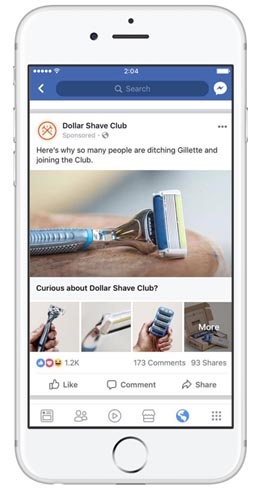
In the past, they’ve tried to appeal to women with their products, which has seen some success. A significant proportion of women follow their Facebook page.
They’ve differentiated themselves from the competition by marketing their razors to both genders. In the grooming industry, the standard practice is to make women’s razors pink and charge even more for the privilege.
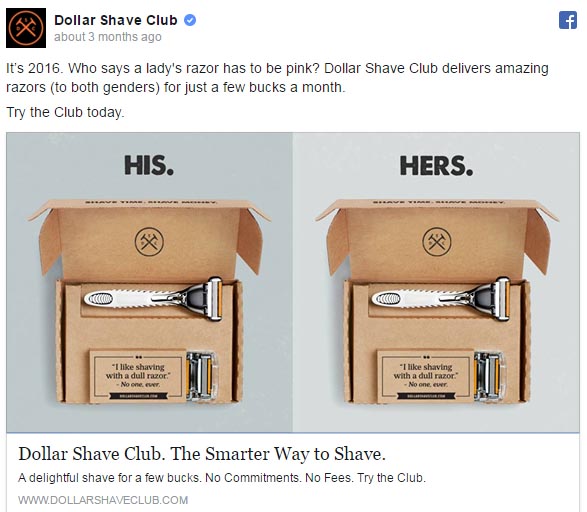
This ad is poking fun at how grooming companies distinguish between men and women’s products, when there’s often no real difference apart from color. They know their customers often feel patronized by this type of marketing, so they’ve cleverly used it as a way to sell their products to more people!
This move by DSC is also a subtle bit of branding that shows they’re progressive and forward-thinking in their attitude to hot-button topics like gender.
This next ad works well because it’s in the form of a customer testimonial, thereby providing social proof to recommend their product. It’s unique hook is that you want to find out what’s so great about this razor and why it’s managed to be so ‘disruptive’.
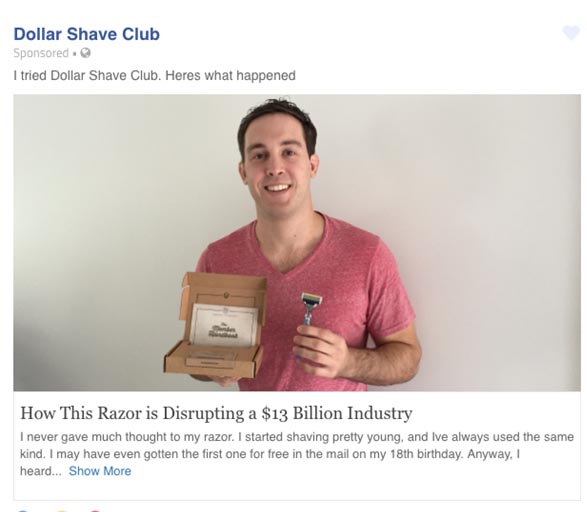
They’ve gone for the regular (albeit muscular) guy talking about how he tried DSC for the first time. Part of their messaging is making sure that their customers know, by joining the DSC club, they will also be disrupting an industry. Who wouldn’t want to be part of that?
Finally, this next ad is part of their ‘razor for a buck’ campaign.
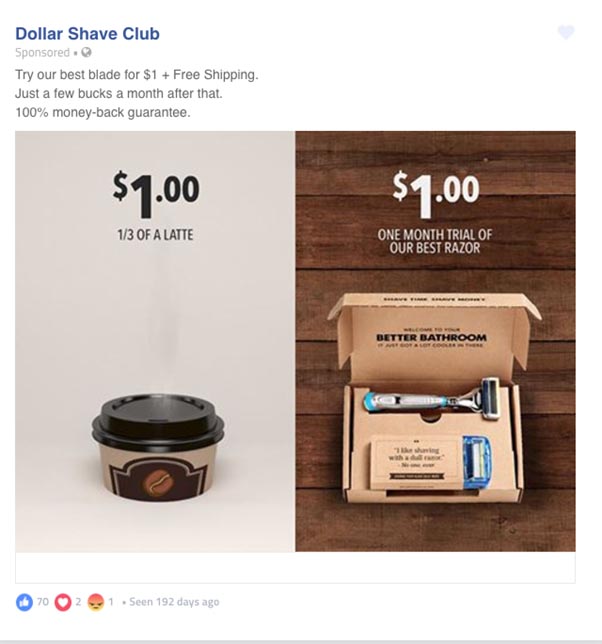
They’re comparing their introductory offer of a starter pack for a dollar with other products of an equivalent price – with a humorous slant. Where DSC are from, a dollar will get you only a third of a latte, which is pretty ridiculous. A month trial of their razor seems far more valuable than that by comparison!
They’ve emphasized their free shipping and a money-back guarantee to remove the risk of customers losing money on a product they end up not wanting.
Recommendation: In your Facebook marketing, you will be competing in the feed with lots of other posts from friends and family. Earn your right to your audience’s attention by presenting them with compelling offers without being overly ‘salesy’. Highlight the benefits of your products rather than focusing on dry features or too much on deals.
All of DSC’s Facebook ads are about creating a more compelling offer than their competitors by simply offering a cheaper deal, or marketing that doesn’t suck. People will always need razors, but DSC can offer a better buying experience with their signature humor and empowering copy.
Video marketing
DSC make a lot of videos since it’s a key part of their content marketing strategy. Their initial viral video was so funny and on-the-mark, that they’ve attempted to replicate their success with repeat videos.
They know that video marketing is one of the most effective ways to generate leads. 45% of people watch more than an hour of Facebook or YouTube videos a week, while men spend 40% more time watching videos than women. DSC’s target age group (men aged 25-34) watches the most online videos of all groups (Wordstream).
With marketing videos, research shows that viewers have almost twice the amount of positive feelings about a brand if they are voluntarily exposed to the ad.
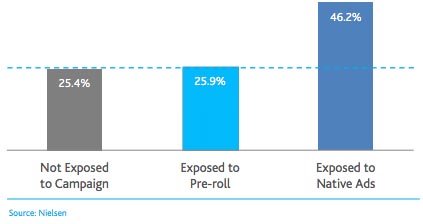
Although this is subjective and hard to measure, it does point to a trend of users who are sick of being bombarded with online advertising. Audiences will view your brand far more favorably if you entertain them and bring a smile to their day.
DSC is absolute proof that this approach works. When they released their original video back in 2012, their site received so much traffic that it crashed – a gut-wrenching moment for any brand. Naturally, they were determined to avoid this happening again during their next high-profile video launch, which was their Super Bowl ad in 2016.
Using Content Delivery Network solution Fastly, DSC managed to prepare for a high volume of visitors (amounting to 190 more times than usual) and avoid any costly crashes. This involves caching as much of your site as possible to reduce the number of requests to your server, which minimizes server loads at the crucial time.
Recommendation: Instead of imposing your video ads on users, make them something your users will want to see. This requires being more inventive and more creative. Avoid invasive pre-roll or autoplay video advertising as much as possible, and instead spend time building buzz around your video. It will be difficult shoehorning humor into your videos if your brand isn’t known for this, so find something compelling that works for you.
Although they smash it with their videos, DSC knows when it’s also time to take their marketing offline. As an ecommerce subscription company, their product packaging plays an equally key role in their content marketing strategy.
Dollar Shave Club product packaging and content marketing
Every product sent to their customers is another chance for DSC to build customer loyalty. Their product packaging continues the brand experience, looks good, and promotes social shares.
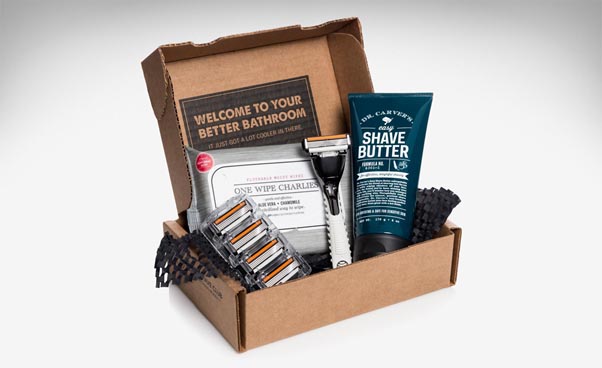
They even send their customers an irreverent postcard that they can fill in to send to a friend, opportunity they’ve tapped for referral marketing that also increases their
social media shares.
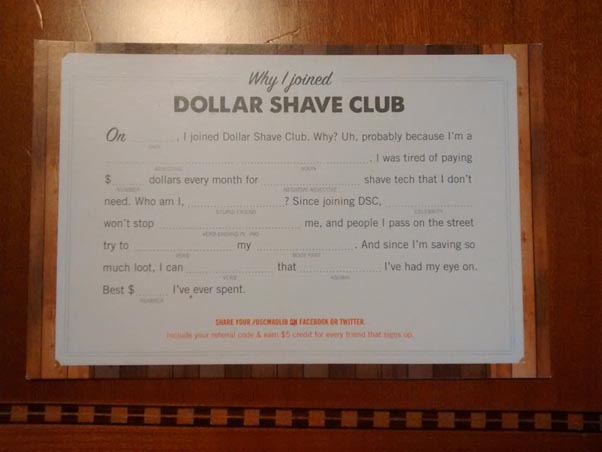
Their publication Bathroom Minutes gives a cheeky nod to the fact that most men take ages in the bathroom. People love it.
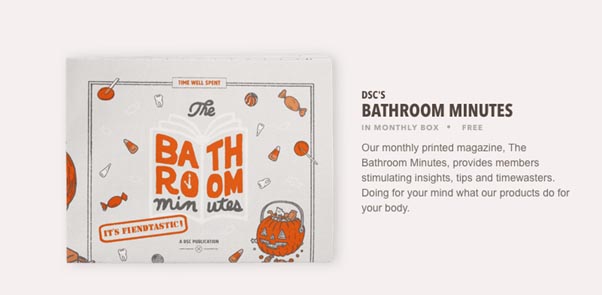
It’s also easy for DSC to incorporate their stylishly designed products into their promotional imagery, which works well for their seasonal promotions. This is a prime time to generate more sales through gift buying and great product imagery will stand out from the crowd.
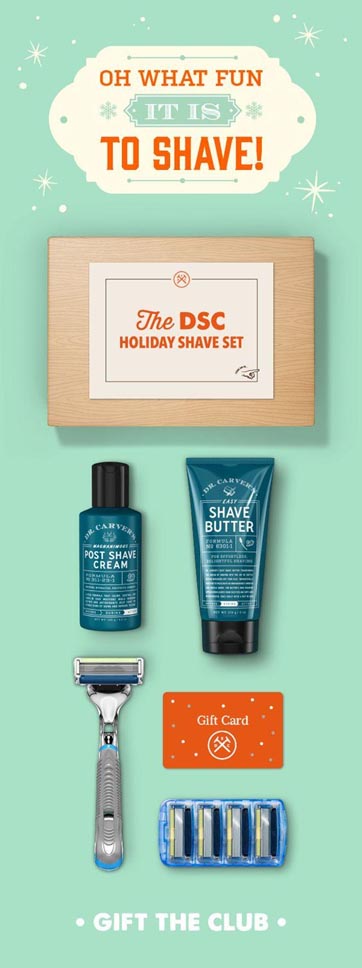
By engaging in content marketing through their product packaging, they increase the chance that their customers retain their subscription and their recurring revenue stays .
Recommendation: As a subscription ecommerce company, focus on the recurring monthly revenue. Keep providing value for your customers so there’s no question that they should keep their subscription. Like DSC, treat your customers like they are part of a private members’ club so they look forward to your products in the mail.
Dollar Shave Club email marketing
Email marketing is another hugely important channel for subscription companies like DSC. It works to onboard customers, keep them engaged, and upsell to them. They use MailChimp for their email marketing campaigns.
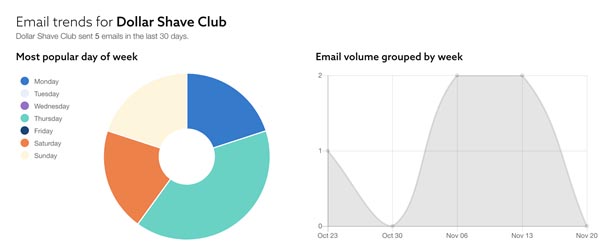
They sent 5 emails in the last 30 days. Their most popular day for sending an email is Thursdays around 2pm, which should be roughly within the lunch hour of most of their customers.
They score 99% for email best practices, which means they do things like:
- Optimize their subject line lengths which are truncated at a certain number of characters varying by service providers. This is where you catch your audience’s attention and show them your email is worth their time.
- Their email templates are optimized for mobile which is the device of choice for 56% of recipients
- Their preview text is well-written, which is the snippet that mail clients show to users that gives them a preview of what the email contains. This is a chance to use compelling copy to get your recipients to open.
- They send emails from an address that customers can reply to, which is far better than using a ‘no reply email address’ because it’s encouraging a more personal two-way dialogue.
- They’ve condensed their image sizes so emails load more quickly in the mailbox.
- They pass the spam filters like avoiding the using of caps lock, spammy words, and excessive exclamation points.
In short, their emails are stylish, snappy and appealing.
Welcome series
DSC is all about their exclusive members’ club and this is reinforced in their email copy. There’s no option to sign up for a traditional email newsletter, but when you click ‘join’ you are taken through the process of selecting your products.
You have to create an account or log in with Facebook to proceed to checkout (which enables DSC to start email retargeting if you abandon). Then, if you don’t complete your purchase, you’re sent an automated email prompting you to return to checkout.
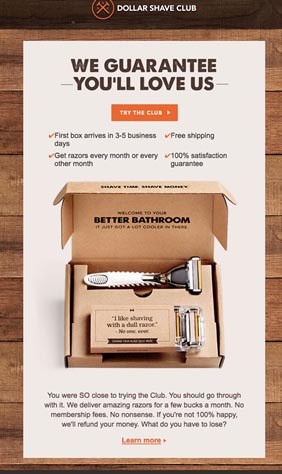
Triggered emails
The hardest part of their task it to get a subscription customer to commit to a purchase for the first time, and they overcome this hurdle with very direct emails that contain increasingly valuable offers.
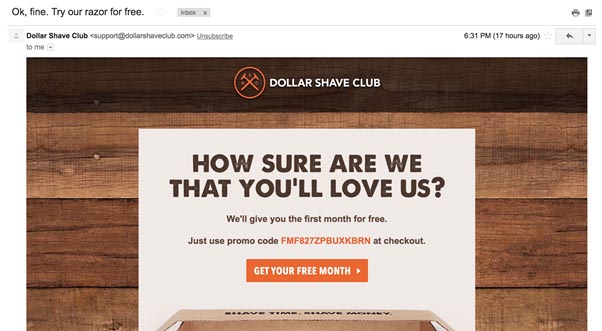
It’s almost tempting to wait and see how much DSC will give their users before you sign up to receive one of their razors.
One huge flaw in their automation is that you receive the same email over and over again if you don’t commit to a purchase. The headline, ‘Ok, fine. Try our razor for free.’ looks less like the spontaneous natural language it has been crafted to mimic, and more like the calculated marketing it is.
Transactional emails
They even take advantage of their transactional emails to ask for referrals from their customers, which is something that most companies miss.
DSC have got it right as transactional emails have open rates of around 70%, compared to the average email open rate of less than 18%. For every ‘receipt’ email that you send, you can make a potential $0.25 more per email.
These emails are on-brand and contain a clear breakdown of the customer’s order.
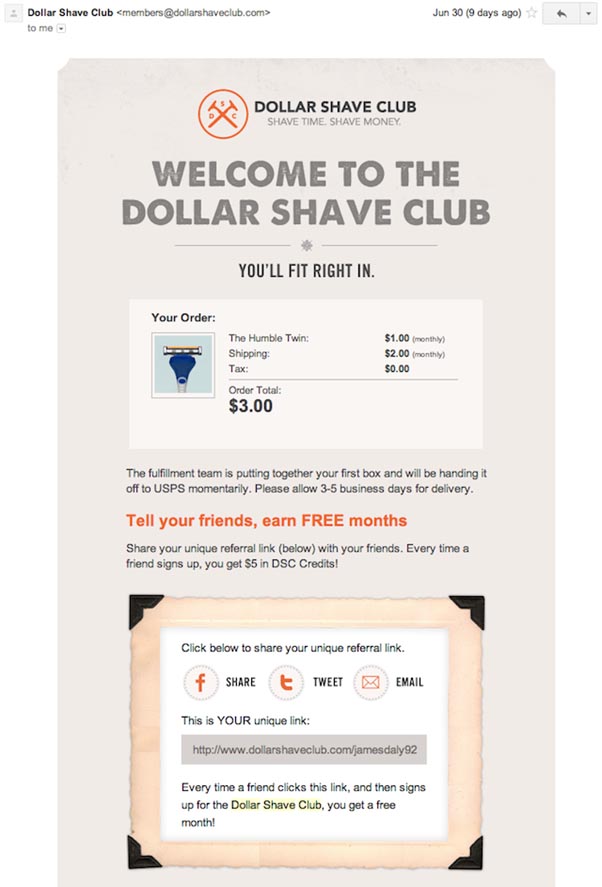
Even better, at the end is a call-to-action for referring DSC to a friend in exchange for free months, which we know is a core part of their marketing strategy. This also earns the customer a free month of subscription, which is another incentive to share.
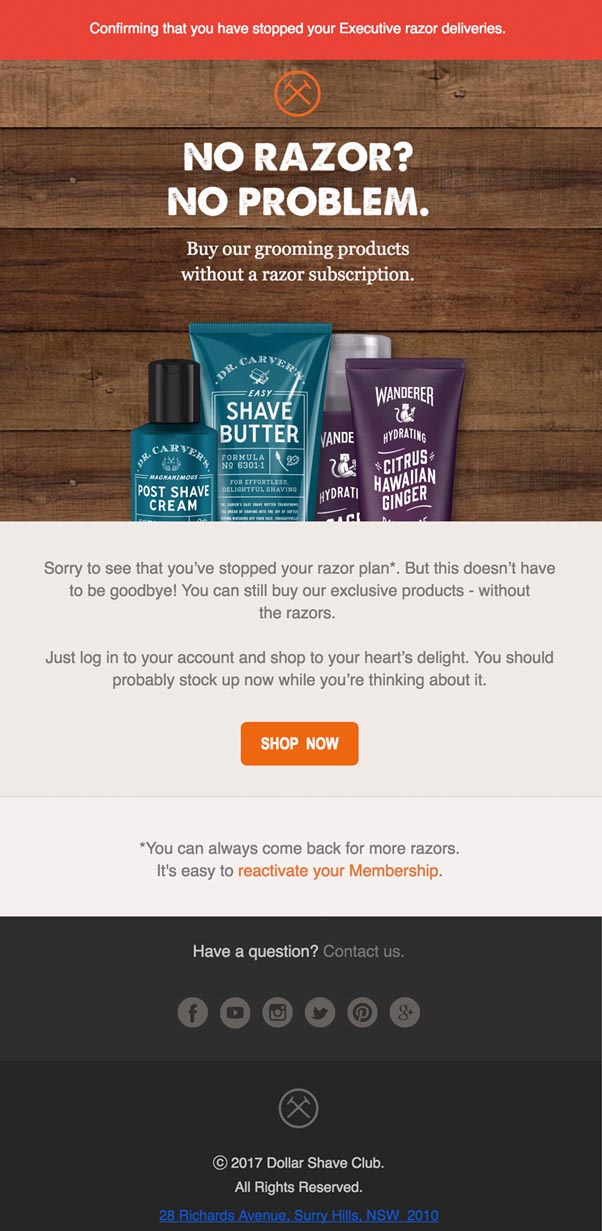
Here’s another example of where they have used another transactional email as an opportunity to market to their customers. They’re reminding their customers that even though they’ve ‘cancelled’ their subscription, they are still able to buy other products from DSC’s online store. It’s another situation where DSC is sneakily upselling to make sure they get the most out of each and every customer.
Email marketing summary
We noticed that not great deal of subject line and content split testing was conducted.
Email volumes have really died down since the Unilever buy out around March 2016, plummeting from four to six emails a month to just two in some months. Their bulk-send emails were not that well thought-out, with usually just one or two email sends.
They make good use of lots of trigger-based evergreen emails, plus extensive cancellation and win-back campaigns. They only have a few promotional emails for key holidays and events such as Father’s day, Christmas and Valentine’s day, but could expand to Mother’s Day and target cyclists for races throughout the year.
Display advertising
Along with targeting their customers right in their inbox, DSC are also making extensive use of Display Advertising around the web.
Here’s a breakdown of which platforms DSC proportionally uses for their Display Advertising.
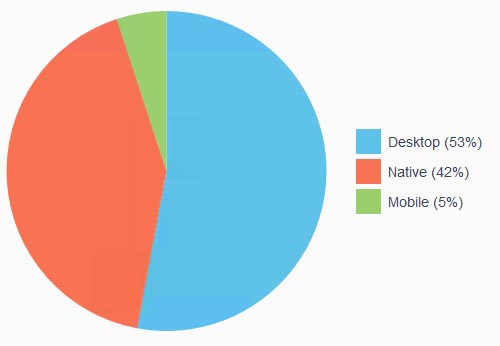
And which networks they’re using:
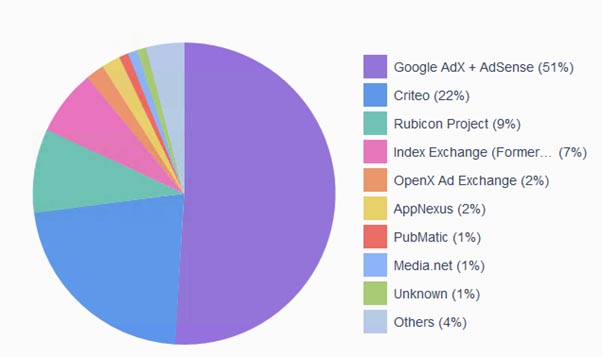
Here’s a breakdown of their top traffic sources for display:
- com – (Answers Corporation) – Google AdX + AdSense
- com – OpenX Ad Exchange
- com (CBS Interactive) – Google AdX + AdSense
- com – Google AdX + AdSense
- com – Google AdX + AdSense
- com/health – Google AdX + AdSense
- com – Google AdX + AdSense
- us – Google AdX + AdSense
- com – Google AdX + AdSense
- com – Google AdX + AdSense
- com – OpenX Ad Exchange
- com – Google AdX + AdSense
- com – Google AdX + AdSense
- com (Reader’s Digest) – Google AdX + AdSense
- net – Google AdX + AdSense
In short, they’re trialling a variety of display ads for the $1 razor offer across different ad networks.
They’ve used a huge variety of different copy and image choice to increase their conversion rate, by finding the versions that work best. They’ve tried many different ways of phrasing the same things – a buck, versus dollar, versus $ – to see which grabs the attention of their audience the most. They also have a variety of targeted landing pages, which is smart.
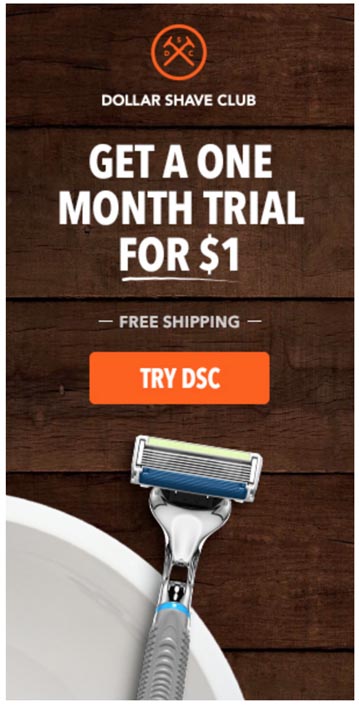
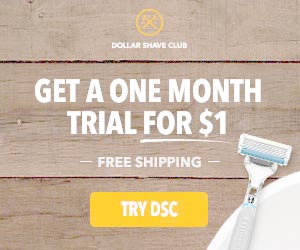
Their ad contains a good hook that urges customers to take advantage of the $1 month trial and get them to sign up.
They’re also running a campaign aimed at military families. Here’s the landing page:
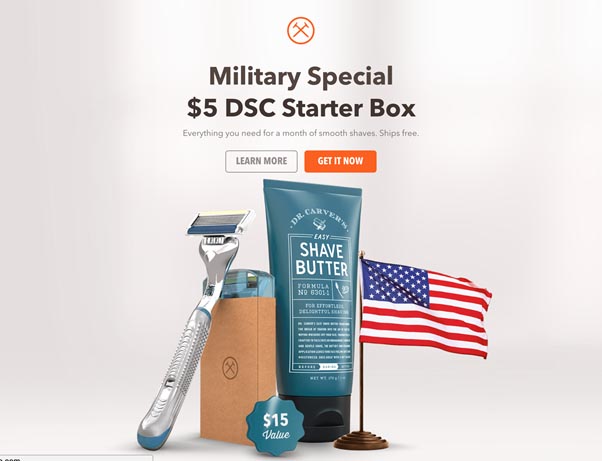
Combining a special offer for military families featuring the American flag with their custom product imagery is a great way to dig deep into a target audience by connecting with their core values. We’ll go into this ad a little more in the ‘customer service’ section.
They’ve also got some seasonal ads which use their trademark humor to attract customers. The custom images are superbly high-quality, increasing the chance of clicks.

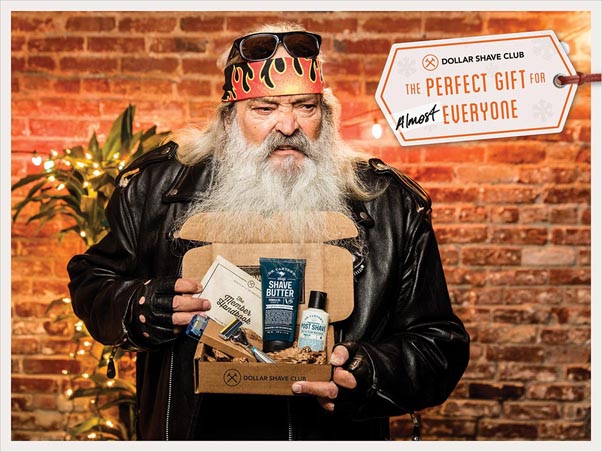
In fact, all of their images are custom creative rather than stock images, fitting in nicely with the overall DSC brand. This is approach is way better than using boring, generic imagery that blurs into the background, making audiences easily skim over it.
Recommendation: The key is to avoid treating your Display ads like a numbers game and come up with some really inspired, compelling content. Connect your creative with your ads team. From the side of the marketer, it’s all about bids, impressions and conversions, but all audiences really care about is if you ultimately helped them or made their day. DSC ads do just that, and also lead to a great product.
Now, let’s take a look at their native advertising to see if they are having the same success here.
Native advertising/sponsored content
In part due to what is known as ‘banner blindness’, brands are increasingly turning to native advertising techniques to drum up more leads. Alternatively called sponsored content, DSC is promoting their content around the web using native advertising to reach a wider audience, bought on a cost-per-click basis.
Only 3% of their traffic is coming from display and native advertising, while their best performing platform is Taboola. They are also using Outbrain to promote their content.
They’ve run an interesting piece of content where a female customer blogs about her experience with Dollar Shave Club. This bucks their marketing trend a little since their customers are usually male.
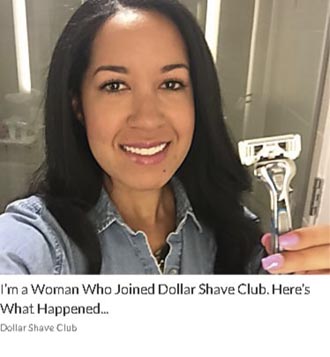
It piques the audience’s interest by raising the question of whether there’s any real difference at all between razors for men, and razors for women.
Ads that blend in with native content are some of the most popular on the web, according to one study run by Nielsen Norman. Since there is such strong backlash against intrusive ads, and a rising number of people using ad blockers, native advertising offers a good opportunity for marketers.
According to another study conducted by Neilsen, images that contain people attract more attention on PC and mobile. Bigger logos result in higher recall in audiences, more action taken, and longer attention placed on ads. In short, it’s all about the imagery, and specific types of imagery at that.
They’ve gone for some more campaigns that explicitly position their products against their competitors, Gillette and Harry’s. Here’s the one about Gillette:
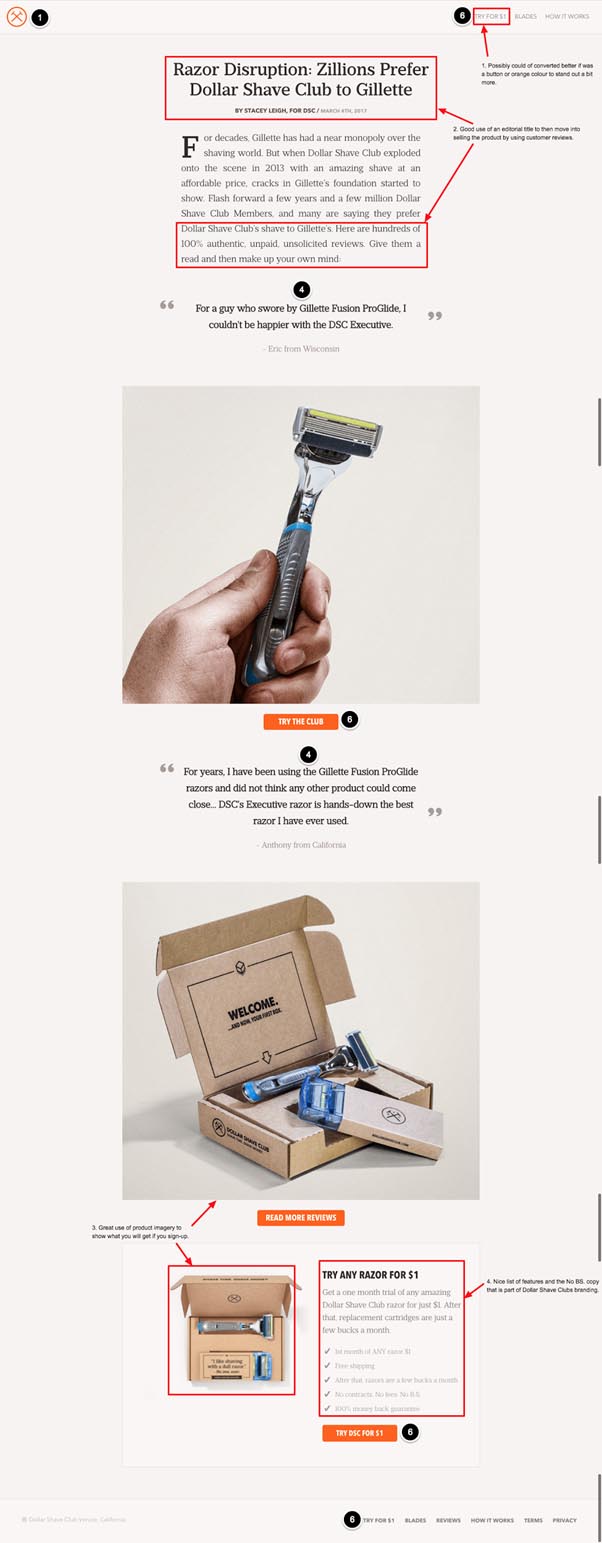
Again, they’ve used the concept of ‘disrupting’ to pull customers into their exclusive club. People love a deal, and they will also want to join the ‘zillions’ who are backing Dollar Shave Club.
The word zillions is slightly tongue-in-cheek (since it doesn’t refer to a real number) which tones down the ad, but still communicates their message that many people love their products.
This is the one they did for Harry’s:

They conducted a very small study in which DSC’s razors came out as superior to Harry’s, and they’ve included the results in this native ad. Since the data is ‘scientific’, this adds to their credibility and dispels any doubts customers may have about the quality of their razors. They also use their superior customer ratings to boost their brand.
Recommendation: To increase your click-through-rate on native advertising, use a high-quality image (no free stock photos!) cropped to the right size. Make sure it contains at least one person, or include your logo prominently. Use persuasive copy to make your headline as clickable as possible.
Referral marketing
Dollar Shave Club has a presence on many important marketing channels but referral marketing is an area where they particularly shine.
Referral marketing is a powerful way to attract new customers and reward existing customers, especially for a humorous and trendy young brand like Dollar Shave Club. It’s an important form of earned (versus paid) advertising, since 92% of consumers trust recommendations from their friends and family (Source) compared to brand websites (58%).
Referrals also work well with DSC marketing themselves as a men’s grooming club, since it mimics the recruitment process of real-life clubs. Once you become a member of their ‘club’, they ask for a cheeky referral just after you’ve bought your first product, as well as a social share.
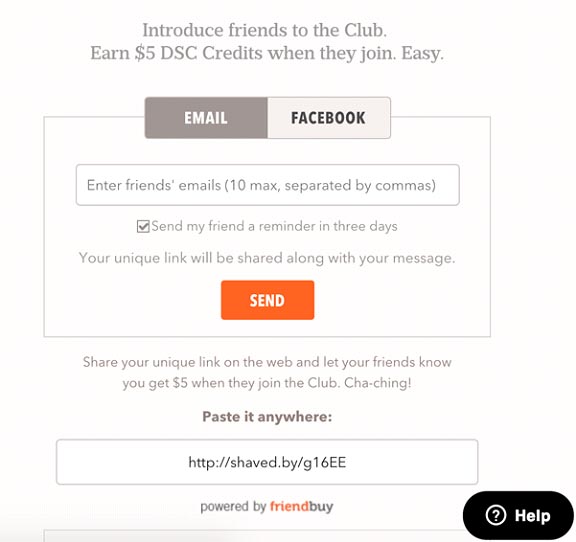
50,000 customers a month refer DSC to a friend (Source). This is a huge number of referrals and has played a big part in their exponential growth. The all-important trust factor is so central to a referral program, which helps a startup with a new offering to quickly gain traction in their target market.
In fact, their viral video is another form of referral marketing. Delighted viewers shared the video with their family and friends on social networks, resulting in more conversions as people discovered the brand through people they already know.
DSC could improve on their existing strategy by using a custom referral landing page that incorporates the customer’s name, like Freshbooks have done in their referral program. This will make each referral more personal.
Recommendation: The best time to ask for referrals is just after the purchase has been completed, because the customer is still highly engaged with you and looking for something else to do. If you do it before, you risk distracting your customers, plus they won’t have anything to refer yet! If you wait too long, the initial buzz after a purchase has already faded away.
Dollar Shave Club internationalization
So far, we’ve looked at all DSC’s different marketing channels, and now we’ll look at how they market internationally. They have an option on their site to toggle between the United States, Australia or Canada.
Only 2% of their visitors are based in Australia, while another 3% are in Canada. This suggests that DSC have not yet invested heavily in marketing themselves outside the United States, so there is a lot of potential for growth here. As they are a budget subscription service, they are strictly limited by the infrastructure they have available to ship to different countries.
This goes some way to explaining why their Canadian site is still using the old template (their Australian site was only updated fairly recently). The old homepage looks a lot busier and more out-of-date, plus it’s not as well optimized for conversions.
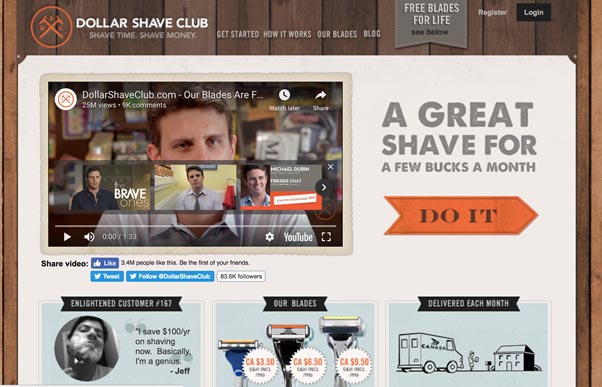
This shows that DSC prioritize their US customers, but are making some small efforts to expand internationally.
Personalization
We know that DSC are mainly focusing on their US customers, but what about personalization within that target market?
DSC is making use of personalization by serving alternative content various customer segments. If you haven’t bought one of their products yet, you see this:
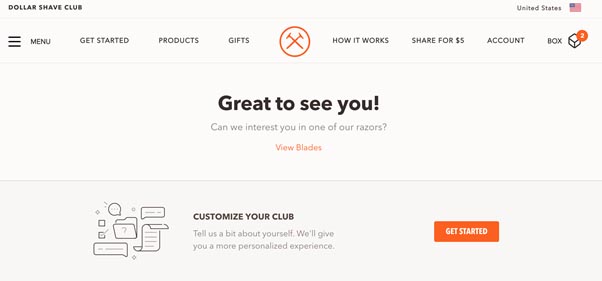
This increases the chance of moving the customer up the conversion funnel. You are more likely to buy a razor for the first time if you see targeted rather than generic messaging.
After completing their survey, the platform shows you recommended products based on your answers about your skin, hair and styling preferences.
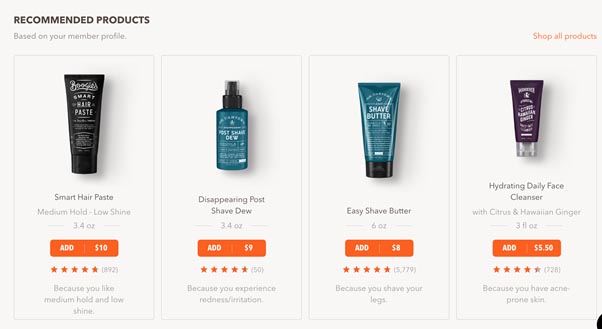
This is great because customers want to see products that are relevant to them. DSC is removing the burden on customers to search for products themselves, and moving them ever closer towards the conversion moment.
Customer Service
What about once you actually buy a product from Dollar Shave Club? We look at how they treat their ‘members’ who are in the subscription plans.
Pretty well, it turns out!
They replace faulty products seamlessly without placing any burden in the customer. Just take a look at this example when they sent another handle to Shep Hyken after his broke. They don’t ask their customers to fill out a lot of complicated forms or send back the faulty product. This particular incident built even more trust in their brand, as Hyken is a well-known influencer in the customer service space.
Some customers complained on Reddit about the quality of DSC’s blades (not that surprising considering the nature of the platform). Sadly, DSC never replied. The thread is dated four years ago, so DSC have missed an opportunity to jump in and create a more positive impression of their brand.
Similarly, they are missing the chance to answer questions about themselves on Q&A site Quora. People asking questions about the brand are very likely to convert. They should have been monitoring online mentions of their brand and jumped in at the right moment to steer the conversation towards a more positive impression of themselves.
Where DSC do excel is at customer service automation. This is a fantastic example of automated customer service to keep the brand loyalty going.
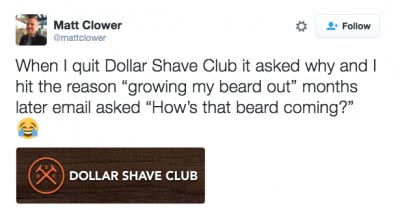
This kind of humorous follow-up is what their customers love.
On the other hand, they could have done better with the following reply to one of their customers, who wanted to cancel their subscription due to DSC’s advertising on Sean Hannity’s Fox News show.
@DollarShaveClub You are currently sponsoring Sean Hannity’s show. He defends child molester Roy Moore and attacks women who speak out against sexual harassment. Please reconsider. The below was less than a satisfactory answer: pic.twitter.com/kmzrBzbSLQ
— Guy Masson (@GuyMasson) November 12, 2017
They chose a corporate, canned response, which was admittedly probably drafted by their legal team.
After that, there was an explosion on twitter that they didn’t really engage with. This is probably their company policy. They could have made this choice due to the fact they’re using Twitter as more of a broadcast platform for their own messaging, and a way to provide customer service, rather than to engage in debates.
It’s too difficult for brands to effectively participate in political debates online. Still, DSC are definitely losing customers by not directly tackling this issue, since their customers obviously care so deeply about it.
On the bright side, they had a big win when they responded to one customer’s enquiry about buying razor blades in bulk for the military. The customer’s base in Afghanistan had lost access to the shop where they normally bought all their supplies.
In answer to the enquiry, CEO Dubin donated 73 packs of DSC razors to the base, plus other bathroom products – completely free.
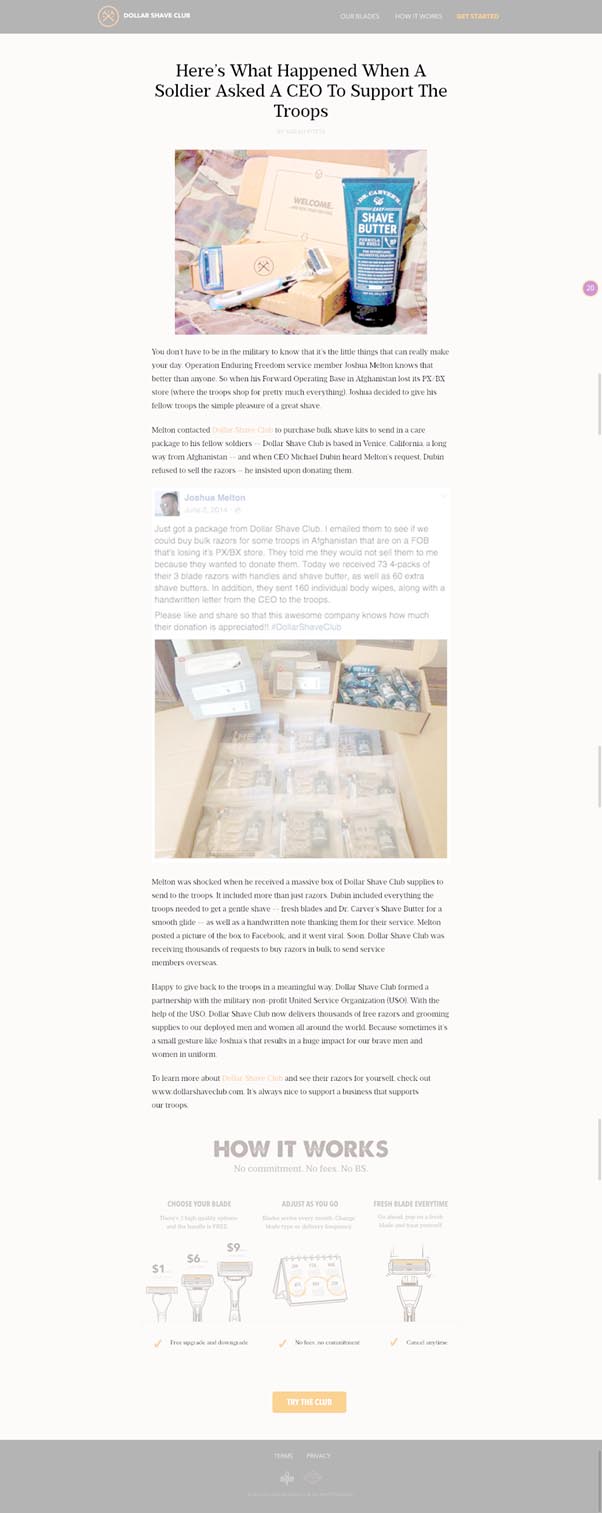
We’re sure that this was an act of genuine altruism of the part of DSC, but it was also an amazing marketing opportunity.
The viral social shares from this story increased their reach, created more brand awareness, and built up more positive impressions. Handily, they also turned the story into a marketing case study.
DSC now have an ongoing partnership with the military in which they donate products to troops.
Dollar Shave Club puts a lot of effort into their customer service, which can be difficult considering their customer base is quite broad. They will never be able to make everyone happy. That makes it even more important to react quickly and tactfully to controversial situations like their advertising on the Sean Hannity show turned sour.
What’s next for Dollar Shave Club
DSC could improve by expanding more into the women’s market and virtually doubling their customer base. This is hard to do with their brand’s sort of humor, which is geared mainly towards men. They’ve made stabs at marketing to women with some of their campaigns, but overall it remains a product directed primarily at men.
They use a combination of inbound and outbound marketing tactics to make sure that new customers continue to hear about them. Their referral marketing strategy is particularly effective, while overall their social strategy could use a bit of work. And, while they cleverly make use of their marketing budget with lots of targeted ads, they must be careful not to come across as ‘spamming’ their audience.
DSC walk the thin line between constructing a friendly, “little guy” type of brand and being owned by a large corporate. Their style of marketing has the potential to come across as a bit disingenuous if anything goes awry (for example, in unchecked automated emails, or sponsoring the wrong kind of show). They must continue to work hard to keep their scrappy startup appeal.
They can accomplish this by staying down-to-earth and downplaying their heavy-duty marketing tactics, so as not to become the classic victim of their own success.
What can you do with this data to boost your own business?
Dollar Shave Club made startup history with a viral marketing video, but they didn’t stop there. They backed it up with a conversion-engine website, an industrious referral program and aggressive email marketing. Their social media generally synchronizes to reinforce their brand.
The result of their legacy is the new blood that now exists in the razor blade market, where once there had been a near-monopoly. Dollar Shave Club has spawned many copycats (the mark of true greatness!) but none that come close to its level of popularity and success.
They’ve also made people laugh with copy and products that empower them – in some ways far harder than building a startup.
Their secret is knowing their customers so well that they can afford to push the boundaries in their marketing. They are funny and irreverent without crossing the line into disgusting or offensive. They manage to turn a relatively mundane product and daily ritual into one their audience is eager – no, excited – to talk about.
So, now that you know a bit about the Dollar Shave Club…
What was your biggest take-away from this case study?
What tactics do you think you could apply in your own business?
What impressed you the most about their marketing execution? Where do you feel they could improve?
Got an Ecommerce Business?
A Free 20 minute call with us could mean a steady 20% Increase in sales each month.









